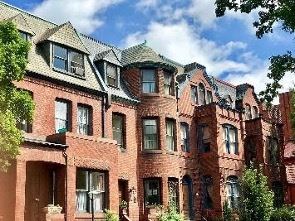- DCCA Home
- DCCA House Tour
- 1624 Riggs Place NW
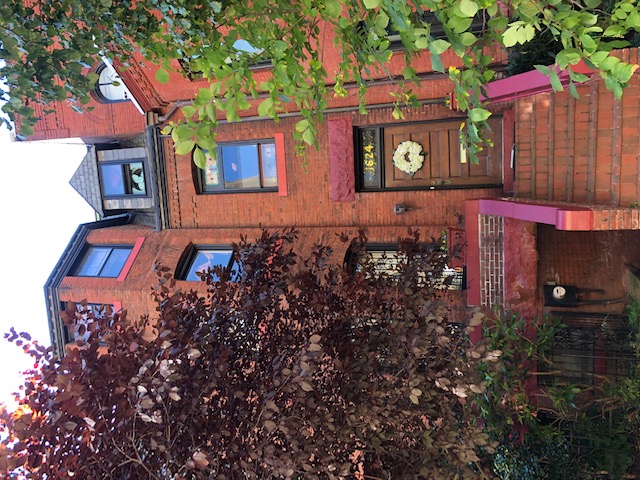 The block-long stretch of Riggs Place between 16th and 17th Street is among the most handsome streets in Dupont Circle. Anchored by the magnificent Toutorsky Mansion (now occupied by the Embassy of the Republic of Congo) to the east and the Rutland Court Apartments to the west, the block consists of three groups of related three-story, red brick townhouses. You will find this home nestled on the south side of Riggs Place, mid-way between the two main thoroughfares of 16th and 17th streets.
The block-long stretch of Riggs Place between 16th and 17th Street is among the most handsome streets in Dupont Circle. Anchored by the magnificent Toutorsky Mansion (now occupied by the Embassy of the Republic of Congo) to the east and the Rutland Court Apartments to the west, the block consists of three groups of related three-story, red brick townhouses. You will find this home nestled on the south side of Riggs Place, mid-way between the two main thoroughfares of 16th and 17th streets.In 1973, the house at 1624 Riggs Place was purchased by Eleanor Traylor. Dr. Traylor taught English at Howard University where she shared an office and began a lifelong friendship with Toni Morrison. Later, she taught at Montgomery College, Hobart and William Smith College and Cornell University and traveled to study African drama in Ghana and Nigeria. In 1990, she was appointed professor of English at Howard University where she chaired the humanities division later becoming chair of the Department of English.
Dr. Traylor also served as director of evaluation procedures at the Duke Ellington School of the Arts as well as a panelist for the National Endowment for the Humanities and the National Endowment for the Arts. She also served on the board of the D.C. Black Repertory Theater Company. She was also an evaluator for the Afro-American Museums Association, a script writer and consultant for the Smithsonian Institution and literature consultant to the National Black Arts Festival.
Dr. Traylor has received many awards and honors for her work, including the Hazel Joan Bryant Award in 1987, the Marcus Garvey Award, the Catholic University Alumni Achievement Award in literary criticism, and the Larry Neal-Georgia Douglas Johnson Award for literature and community service. In 1993, Dr. Traylor was honored with the African Heritage Studies Association Community Service Award and the Amoco Foundation’s Excellence in Teaching Award. In addition to receiving a Doctor of Humane Letters from Spelman College in 2002, Dr. Traylor was also awarded an Honorary Doctorate of Letters from Howard University in 2017.
The Interior
1624 Riggs Place has been lovingly maintained with a rich period interior. Dr. Traylor hosted regular salons, inviting many of the most influential authors a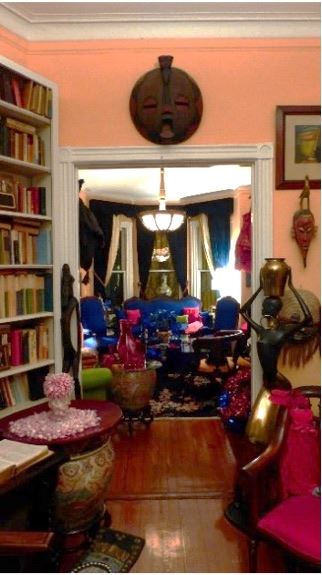 nd scholars of the latter half of the last century and of this one. These included Paule Marshall, Maya Angelou, Toni Morrison, Larry Neal, Beverly Sheftall, and Paula Giddings. She has continued to host and encourage scholars from Howard, Catholic and Georgetown Universities at her home.
nd scholars of the latter half of the last century and of this one. These included Paule Marshall, Maya Angelou, Toni Morrison, Larry Neal, Beverly Sheftall, and Paula Giddings. She has continued to host and encourage scholars from Howard, Catholic and Georgetown Universities at her home.
Dr. Traylor designed the funeral of her friend James Baldwin at the Cathedral Church of Saint John the Divine in New York. Her writing about that event captures the breadth of her scholarship and her determination to maintain a sense of wonder at the beauty and potential of the world.
“But when there comes a sound – perhaps a voice – like the folk and learned thunder of the black preacher’s voice, or the close harmony of a church choir, embodied in a single instance like the voice of Dr. King raising up our desire for civil rights and freedom from prosecution for being black, or the voice of Aretha Franklin raising up our desire for respect, our pursuit of joy, and our findings… then, beauty in the provenance of wonder becomes a consensus of consciousness: love for eloquence of expression, elegance of appearance, and uncommon articulation of shared desire.”
The Provenance of Wonder, Eleanor W. Traylor (2020). In Deep Beauty, Rosemary Winslow and Catherine Lee (eds.)
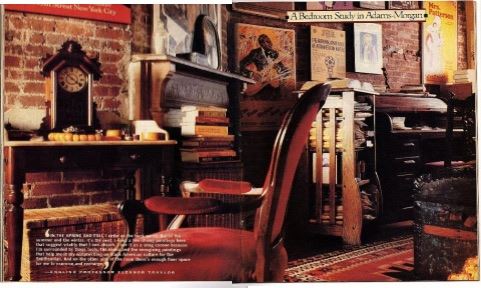
From Washington Post Magazine, October 5th, 1986
The Building's History
1624 Riggs Place was designed by Harvey L. Page, a renowned Washington, D.C. architect. Page spent his earliest years in partnership with William Bruce Gray and introduced a style of “renaissance blended with the modern” while designing both private and public buildings in the newly fashionable Dupont Circle area.
On his own, Page continued to design expensive single family housing in the Dupont Circle area. The most significant surviving example of these dwellings is the Sarah A. Whittemore house (now the Women’s National Democratic Club) located at 1526 New Hampshire Avenue, NW, which was built in 1892-94. Other examples of his work include the two large Romanesque revival residences at 1708 Massachusetts Avenue NW and 1628 16th St. NW and the row of 16 houses constructed from 1708 Massachusetts Avenue NW (which is now the Embassy of Trinidad and Tobago).
However, the group of row homes on the 1600 block of Riggs Place NW is the only remaining example of his contribution to modest residential design. These 16 homes, constructed in 1893 with Seneca Red Sandstone, on what is known as the Harvey L. Page block, represent a well-preserved collection of late 19th century residential architecture and workmanship in the Dupont Circle Historic District. In 1984, the National Park Service described the block as a "beautifully preserved enclave much praised for its original stained glass and brick and copper work."
| 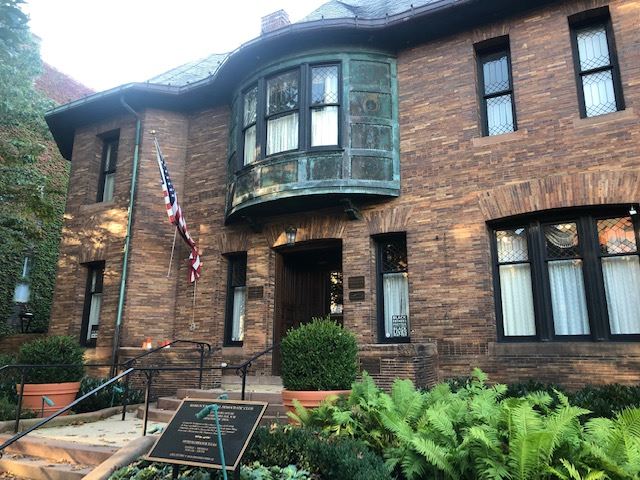 |
Home to Other Notable Residents
The earliest recorded resident of 1624 Riggs Place was Edward M. Dawson, Chief Clerk in the Department of the Interior, who was reported to be in residence in 1892. In 1896, Senator George Wycliffe McBride was staying there. In 1897, Mr. J. Y. Paige, Chief Clerk, Controller of the Currency was living at this address. The Congressional Directory indicated that in 1906 the house was occupied by Mr. Otto Tittmann, Superintendent of the Coast and Geodetic Survey.
By 1911, the Spanhoofd family were in residence. Mr. Walter Spanhoofd was appointed as a teacher in the DC ‘Colored High Schools’ in 1899. His daughter, Wilhemina, attended the Friends School. By 1914, he was Head of the Modern Language Department for all the District High Schools before moving to a position at Georgetown University. His wife was an active member of the Daughters of the American Revolution and his daughter was married in the house in 1924.
The Neighborhood
A neighborhood which is now labeled the “Strivers’ Section” lies to the north of this block of Riggs Place. The term “Strivers” was seemingly intended to be disparaging, suggesting an attempt by some black families to escape poverty. The area was largely rural farmland in the early 19th century but was platted for development by 1852, establishing its current configuration of streets, alleys, and lots. The land was purchased by speculators who built over 150 houses between 1873 and 1875. The houses were popular and its proximity to streetcar routes and to Howard University attracted members of Washington’s black elite.
In the late 1890s the area was racially mixed offering accommodation to some freed slaves and, towards the end of the century, Howard University graduates newly entering the professions. For example, just around the corner in the 1700 block of 17th street NW, Richard T. Moss had purchased a house in 1881. He had attended Howard University Preparatory School, and Howard University, graduating in 1876 at the age of 20 with B.A. He was the class salutatorian. He began teaching and by 1879 was teaching the fifth grade at the Mott School, eventually becoming the school’s principal.
Black and white workers who held jobs in nearby factories settled in the area as well. But by 1910, Riggs Place and surrounding streets had become all-white and by 1920, the entire area was effectively divided into Black streets and white streets.
Note: This description was written with the kind assistance of Dr. Eleanor Traylor, but any errors remain the responsibility of DCCA.
